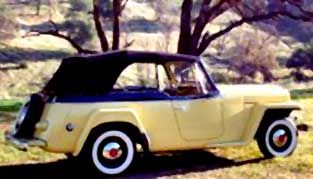
SAN FRANCISCO: The Jeepster Phaeton convertible, introduced for the 1948 model year, was
based on the 104 inch wheelbase Jeep, model 4-36 4 X 2, station wagon chassis that came
out right after the war in 1946. The '48 lineup also included a panel delivery, a pickup (
in 2 or 4WD), and a platform-stake as well as the wagon and the Jeepster Phaeton .
Our feature car, a 1950 model, was rebuilt from a tatty yard decoration
found on the San Francisco Peninsula by Gerry Peter who lives in suburban Sacramento, CA.
No stranger to auto restoration, Jerry also owns a '48 Chevy, three MGs, and a Jag XK 140.
The Jeepster was not his first restoration but it was a major lesson in auto body work. It
had been left out in the elements and developed rusty floors and had a nasty rumple in the
left rear corner. This was a perfect project for the autobody class Gerry was starting at
Solano College. He had successfully painted cars at home in the past but wanted to learn
the finer points of professional metalworking.
This was not a "frame off" restoration as the body and frame
stayed together, but all else was removed. After the floors were replaced Gerry worked
hours on that bent rear corner. The teacher wasn't satisfied until Gerry had done the work
over a number of times. The damage is now undetectable. The Jeep was painted its original
pale yellow with black trim.
The rest of the car was refurbished piece by piece. Every part was
either replated, repainted, reupholstered, or polished, then re-installed with new rubber
and hardware. Final touches include a black canvas top, whitewalls tires and some super
reproduction hubcaps imported from Israel, of all places. The quality of the restoration
is superb.
The Classic Drive
The first impression one has of the Brooks Stevens designed bodywork is
sport tourer. It has a raked back windscreen and sidecurtains like a classic British
roadster. From some angles, it "feels" MG but after closer inspection, nautical
is the word that comes to mind. The interior has the sturdy, uncomplicated, and
well-finished look of a '40s era amusement park ride - lots of painted metal and tube
frame seats. An ample door allows easy entry to the spacious seating area. Wow, a six
passenger sports car!
Any sporting car illusions are quickly dashed with the turn of a key
and a step on the floor mounted starter pedal. The results are strictly agricultural in
sound and feel. This Jeepster came equipped with the F-head 4-cylinder engine. Many of
these came with a sidevalve six and some earlier models had sidevalve fours. The uprated
F-head four, new for 1950, had only seven fewer horsepower than the six and provided
similar overall performance.
Once in motion, we find an engine that's as high revving and flexible
as a forklift and a wide ratio, three-speed, column mounted stick. Not exactly sports car
material. The engine in Gerry's Jeep was balanced during the rebuild so it runs smooth and
works well. It took some time mentally working out the torque curve and getting the shift
points just right but soon I was bombing along a winding country road fast enough to
realize that the little Jeepster had firm suspension, very little lean, and good
directional response. Its longer wheelbase makes the car less "whippy" than a CJ
series Jeep though the high center of gravity and cross-ply tires discouraged any REAL
cornering test.
Compared to other domestic cars of the same vintage it's a pretty good
sportster. Somewhere between a MG roadster and Ford sedan. Engaging the overdrive quieted
down the hard working F-head on the open road. I drove the car sidecurtain-less on a
mid-December morn and was really impressed by the lack of cold wind in the face motoring.
It seems that the driver sits close to the tall V'd windscreen and when the wing windows
are extended fully the wind blows right past. I'm sure back seat passengers wouldn't be so
lucky.
Did I like it? You bet. The bodywork promises sport but the Phaeton
comes into better perspective if viewed as a stylish, better-appointed, six passenger
Jeep. The Jeepster was built on a light truck chassis and was never intended to be a
sports car. If you live in a warm area, even today, this would be an excellent runabout.
It's easy to drive and park, uses little gas, really attracts attention and parts are
still relatively easy to find.
Why didn't Jeep sell more of these? In its day, the Jeepster cost just
a few hundred dollars less than a power-top Chevy convertible. Most open car buyers would
opt for a car with roll up windows, plusher interiors and more powerful engines, but there
was a certain type of person that lived in just the right place that found these beauties
irresistible. By Rick Feibusch © AutoWire.Net - San Francisco

Byline: By
Rick Feibusch © AutoWire.Net - San Francisco
Column Name: The Classic Drive
Topic: The 1950 Jeepster
Word Count: 827
Photo Caption: 1950 Jeepster
Photo Credits: Rick Feibusch
Series #: 1999 - 45


|
